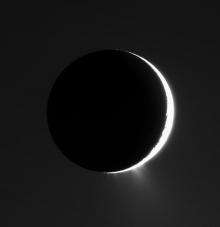Scientists find signs of liquid water in Saturn's moon

(PhysOrg.com) -- Scientists working on the Cassini mission to Saturn have found evidence of liquid water on the planet's icy moon Enceladus, suggesting the possibility of life below its surface.
Scientists working on the Cassini space mission have found negatively charged water ions in the ice plume of Enceladus. Their findings, based on analysis from data taken in plume fly-throughs in 2008 and reported in the journal Icarus, provide evidence for the presence of liquid water, which suggests the ingredients for life inside the icy moon. The Cassini plasma spectrometer, used to gather this data, also found other species of negatively charged ions including hydrocarbons.
“While it’s no surprise that there is water there, these short-lived ions are extra evidence for sub-surface water and where there’s water, carbon and energy, some of the major ingredients for life are present,” said lead author Andrew Coates from University College London’s Mullard Space Science Laboratory.
“The surprise for us was to look at the mass of these ions. There were several peaks in the spectrum, and when we analysed them we saw the effect of water molecules clustering together one after the other.” The measurements were made as Cassini plunged through Enceladus’ plume on March 12, 2008.
Enceladus thus joins Earth, Titan and comets where negatively charged ions are known to exist in the solar system. Negative oxygen ions were discovered in Earth’s ionosphere at the dawn of the space age. At Earth’s surface, negative water ions are present where liquid water is in motion, such as waterfalls or crashing ocean waves.
The Cassini plasma spectrometer, originally designed to take data in Saturn’s magnetic environment, measures the density, flow velocity and temperature of ions and electrons that enter the instrument. But since the discovery of Enceladus’ water ice plume, the instrument has also successfully captured and analysed samples of material in the jets.
Early in its mission, Cassini discovered the plume that fountains water vapour and ice particles above Enceladus. Since then, scientists have found that these water products dominate Saturn’s magnetic environment and create Saturn’s huge E-ring.
At Titan, the same instrument detected extremely large negative hydrocarbon ions with masses up to 13,800 times that of hydrogen. A paper in Planetary and Space Science by Coates and colleagues in December 2009 showed that, at Titan, the largest hydrocarbon or nitrile ions are seen at the lowest altitudes of the atmosphere that Cassini flew (950 kilometers (590 miles). They suggest these large ions are the source of the smog-like haze that blocks most of Titan’s surface from view. They may be representative of the organic mix called “tholins” by Carl Sagan when he produced the reddish brew of prebiotic chemicals in the lab from gases that were known to be present in Titan’s atmosphere. Tholins that may be produced in Titan’s atmosphere could fall to the moon’s surface and may even make up the sand grains of the dunes that dominate part of Titan’s equatorial region.
The new findings add to our growing knowledge about the detailed chemistry of Enceladus’ plume and Titan’s atmosphere, giving new understanding of environments beyond Earth where prebiotic or life-sustaining environments might exist.
More information: saturn.jpl.nasa.gov/index.cfm
Provided by Science and Technology Facilities Council





















